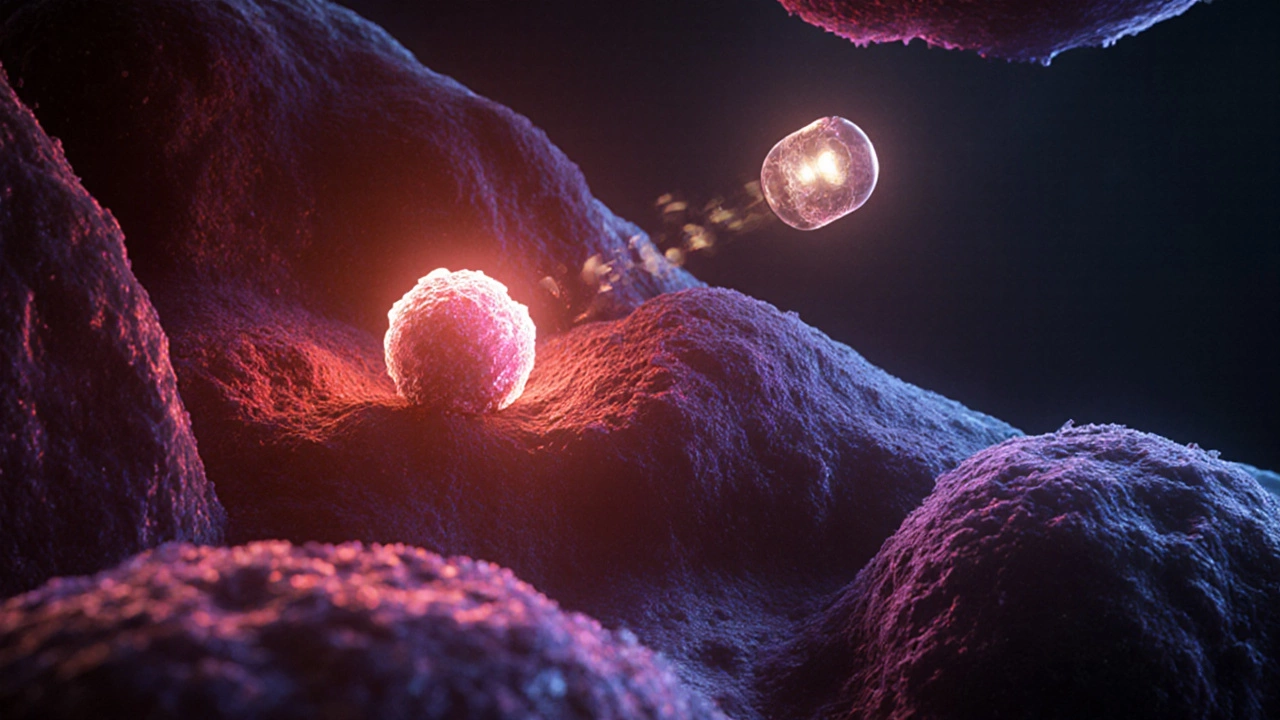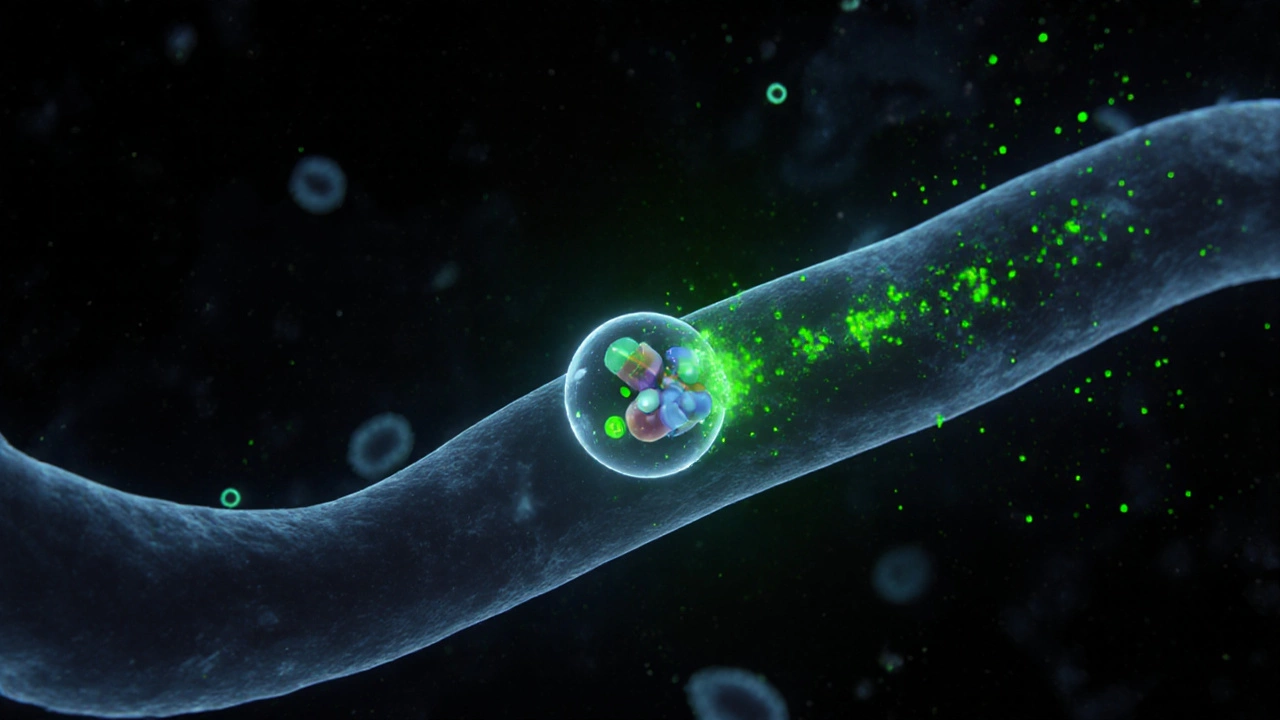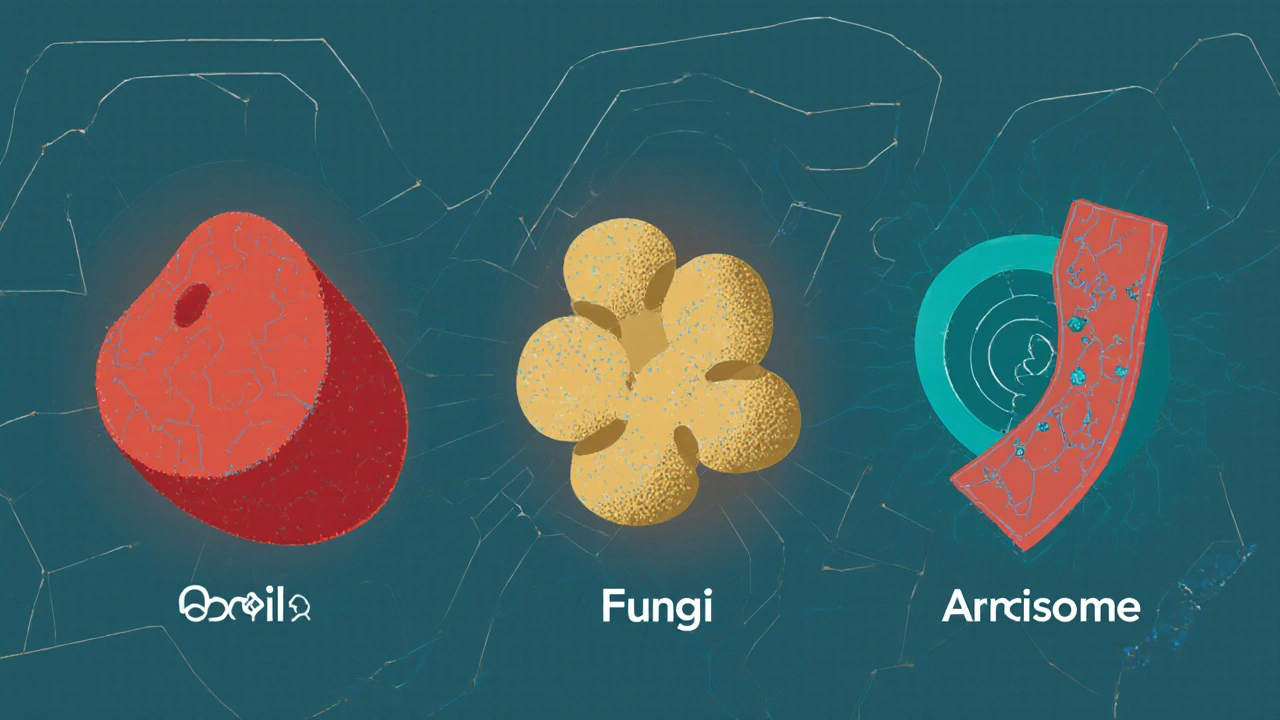What Drugs Use Nanoparticles? A Clear Guide to Nanomedicine Today
 Oct, 28 2025
Oct, 28 2025
Nanoparticle Drug Comparison Tool
Find Relevant Nanoparticle Treatments
Enter your condition or treatment type to see which nanoparticle-based drugs are FDA-approved for your situation.
When you hear the word nanoparticle, you might think of sci-fi gadgets or futuristic labs. But right now, in hospitals and clinics around the world, nanoparticles are quietly changing how medicine works. These tiny particles - smaller than a virus - are being used to deliver drugs more precisely, reduce side effects, and even treat diseases that used to be nearly impossible to manage. So what drugs actually use nanoparticles? The answer isn’t just one or two. It’s dozens - and growing fast.
How Nanoparticles Work in Medicine
Nanoparticles are particles between 1 and 100 nanometers in size. To put that in perspective, a human hair is about 80,000 nanometers wide. At that scale, materials behave differently. They can slip through barriers in the body that larger molecules can’t, cling to specific cells, and release drugs slowly over time.
Traditional pills or injections spread drugs everywhere - your stomach, your liver, your kidneys. That’s why chemotherapy makes you sick: it kills cancer cells, but also healthy ones. Nanoparticles fix that. They’re designed to target only the cells that need treatment. Think of them like smart delivery trucks that only stop at the right address.
Drugs That Use Nanoparticles
There are now over 50 FDA-approved nanoparticle-based drugs globally. Here are the most common ones you’ll actually encounter in treatment:
- Doxil - This is the first nanoparticle cancer drug approved in the U.S. (1995). It wraps the chemotherapy drug doxorubicin in a lipid shell, reducing heart damage and letting more of the drug reach tumors. Used for ovarian cancer, Kaposi’s sarcoma, and multiple myeloma.
- Abraxane - Paclitaxel, a powerful chemo drug, is bound to albumin nanoparticles. This lets doctors give higher doses without toxic solvents. Used for breast, lung, and pancreatic cancers.
- Onivyde - A liposomal form of irinotecan, used for advanced pancreatic cancer. The nanoparticle protects the drug until it reaches the tumor, where it slowly releases.
- Ambisome - A liposomal version of amphotericin B, an antifungal drug. It reduces kidney damage, which was a major problem with the older version. Used for serious fungal infections like cryptococcal meningitis.
- Marqibo - Vincristine packed in liposomes. Used for acute lymphoblastic leukemia. The nanoparticle helps the drug stay in the bloodstream longer and reach leukemia cells more effectively.
- Vyxeos - A combination of cytarabine and daunorubicin in a single nanoparticle. Designed for acute myeloid leukemia. The fixed ratio ensures both drugs hit cancer cells at the same time.
- Definity - Not a drug, but a diagnostic nanoparticle. Microbubbles coated with lipids that show up clearly on ultrasound. Used to improve heart imaging.
These aren’t experimental. They’re standard care in oncology, infectious disease, and imaging. And they’re not just for cancer. Nanoparticles are being used to deliver gene therapies, antibiotics for resistant infections, and even brain drugs that need to cross the blood-brain barrier.
Why Nanoparticles Are Better Than Traditional Drugs
Let’s compare a regular chemo drug to its nanoparticle version:
| Feature | Traditional Drug | Nanoparticle Drug |
|---|---|---|
| Targeting | Spreads through entire body | Focuses on diseased cells |
| Dosage | High doses needed | Lower doses, same effect |
| Side Effects | Severe: nausea, hair loss, organ damage | Reduced: fewer toxic reactions |
| Half-life | Hours | Days |
| Delivery to Brain | Usually blocked | Can cross blood-brain barrier |
That last point matters. For brain tumors or Alzheimer’s, most drugs can’t get past the blood-brain barrier. Nanoparticles can. That’s why researchers are testing them for delivering drugs to treat Parkinson’s, ALS, and even brain infections.

What’s Coming Next
Nanoparticle drugs aren’t stuck in the past. In 2024, the FDA approved the first nanoparticle-based mRNA vaccine for melanoma - a personalized cancer vaccine that uses lipid nanoparticles to deliver tumor-specific instructions to immune cells. It’s not just about delivering drugs anymore. It’s about teaching the body to fight disease.
Other breakthroughs include:
- Nanoparticles that release drugs only when they sense tumor acidity or heat.
- Iron oxide nanoparticles that can be heated with magnetic fields to kill cancer cells directly.
- Hybrid nanoparticles that combine imaging and therapy - you can see the drug working in real time.
Companies like Moderna and BioNTech already use lipid nanoparticles in their COVID-19 vaccines. That technology is now being adapted for flu, HIV, and even malaria vaccines.
Who Benefits Most?
Nanoparticle drugs aren’t for everyone - yet. They’re mostly used when:
- Traditional drugs fail or cause too many side effects.
- The disease is hard to reach (like brain tumors or deep-seated infections).
- Patients need long-term, low-dose treatment (like chronic arthritis or autoimmune disorders).
They’re also expensive. Doxil costs about $1,500 per dose, compared to $100 for regular doxorubicin. Insurance often covers them for approved uses, but access varies. In the UK, NICE evaluates them case by case. In the U.S., Medicare covers most FDA-approved nanomedicines.
But costs are dropping. As manufacturing scales up, prices are expected to fall 30-50% by 2028. That’s when nanoparticle drugs will move from specialty care to mainstream use.

What’s Holding Them Back?
It’s not science. It’s regulation and manufacturing.
Nanoparticles are complex. Two batches made with the same ingredients can behave differently if the particle size varies by 5 nanometers. That’s why the FDA requires strict quality control. Many small labs can’t meet those standards.
Also, doctors aren’t always trained to use them. A 2023 survey of U.S. oncologists found that nearly 40% felt unsure about when to switch from traditional chemo to nanoparticle versions. Education is catching up - but slowly.
Final Thoughts
Nanoparticle drugs aren’t magic. They’re not going to cure everything overnight. But they’ve already saved lives that traditional medicine couldn’t reach. From cancer to fungal infections to brain diseases, they’re making treatment more precise, less toxic, and more effective.
If you or someone you know is facing a tough diagnosis - especially cancer, a resistant infection, or a neurological condition - ask your doctor: Is there a nanoparticle version of this drug? It might not be the first option, but it could be the one that changes everything.
Are nanoparticle drugs safe?
Yes - but they’re not risk-free. All FDA-approved nanoparticle drugs go through the same safety testing as traditional drugs, often with extra scrutiny because of their complexity. Side effects are usually milder than with conventional versions, but allergic reactions, liver stress, or immune responses can still happen. Long-term data is still being collected, but so far, approved drugs like Doxil and Abraxane have strong safety records after decades of use.
Can nanoparticle drugs be taken orally?
Most can’t - yet. The stomach and intestines break down nanoparticles before they can be absorbed. That’s why most are given by IV. But researchers are working on oral versions using protective coatings and special polymers. Early trials show promise for diabetes and inflammatory bowel disease. Don’t expect pills for cancer yet, but that’s the goal.
Do nanoparticle drugs work for all cancers?
No. They work best for solid tumors that are accessible to blood flow and have specific markers - like HER2 in breast cancer or CD33 in leukemia. For fast-spreading cancers or those with poor blood supply, nanoparticles still struggle. Researchers are developing new targeting molecules to fix this, but it’s a work in progress.
Are nanoparticle drugs used outside of cancer?
Absolutely. Ambisome treats life-threatening fungal infections. Definity improves heart scans. Liposomal lidocaine reduces pain during surgery. Nanoparticles are being tested for delivering insulin, antibiotics for resistant bacteria, and even vaccines for Alzheimer’s. Their use is expanding fast.
Why aren’t nanoparticle drugs cheaper?
Manufacturing them is complex. Each particle must be nearly identical in size, shape, and drug load. That requires advanced equipment and strict quality control. A single batch can take weeks to produce. As more companies enter the market and production scales up, prices will drop. Generic versions of Doxil are already in development and could cut costs by half by 2027.
If you’re considering treatment options, ask your medical team about nanoparticle alternatives - especially if standard treatments have failed or caused serious side effects. This isn’t science fiction. It’s modern medicine, and it’s already helping real people.